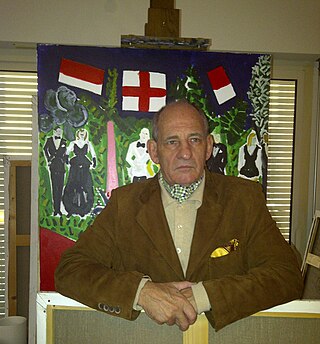
Belgrano is a northern and leafy barrio or neighborhood of Buenos Aires, Argentina.

Raúl Soldi was an Argentine painter and production designer whose work treated various subjects, including landscapes, portraits, the theater and the circus, and nature. His theatrical figures are renowned for their melancholy appearance. He also illustrated poetry books.

Emilio Pettoruti (1892–1971) was an Argentine painter, who caused a scandal with his avant-garde cubist exhibition in 1924 in Buenos Aires. At the beginning of the twentieth century, Buenos Aires was a city full of artistic development. Pettoruti's career was thriving during the 1920s when "Argentina witnessed a decade of dynamic artistic activity; it was an era of euphoria, a time when the definition of modernity was developed." While Pettoruti was influenced by Cubism, Futurism, Constructivism, and Abstraction, he did not claim to paint in any of those styles in particular. Exhibiting all over Europe and Argentina, Emilio Pettoruti is remembered as one of the most influential artists in Argentina in the 20th century for his unique style and vision.

Héctor Julio Páride Bernabó was an Argentine-Brazilian artist, researcher, writer, historian and journalist. His nickname and artistic name, Carybé, a type of piranha, comes from his time in the scouts. He died of heart failure after the meeting of a candomblé community's lay board of directors, the Cruz Santa Opô Afonjá Society, of which he was a member.
Ramón Antonio Carulla is a Cuban artist.
There are many landmarks in Buenos Aires, Argentina some of which are of considerable historical or artistic interest.

Rogelio Yrurtia was a renowned Argentine sculptor of the Realist school.

Manuel Zorrilla de la Torre was an Argentinian painter, illustrator, engraver, drawer, and sculptor. His parents were Spanish immigrants.
Alfredo Da Silva was a painter, graphic artist, and photographer, known for his abstract expressionism. He came to international prominence in 1959 and remained so until his death in 2020.

The Eduardo Sívori Museum is a municipal art museum in Buenos Aires, Argentina.

Manuel Espinosa was an Argentinian painter.

José Fioravanti was a prolific Argentine sculptor known for the many civic monuments he created.

Horacio Rodolfo de Sosa Cordero, tenth Marquis de Sosa, was an Argentine painter, sculptor and ceramicist.

Juan Nicolás Melé was an Argentine sculptor, painter, and art critic. Melé was a member of the Asociación Arte Concreto-Invención as well as co-founder of the Grupo Arte Nuevo.
Carlos María "Rhod" Rothfuss was a Uruguayan-Argentine artist who specialized in painting and sculpture. He was considered a key theoretician for the development of the concrete art movement in Argentina in the 1940s and was a founding member of the international Latin American abstract art movement, Grupo Madí.

Roberto Lucio Pignataro (1928–2008) was an Argentine Informalist artist. He was known for the innovative composition technics he developed and diversity of styles he applied to his artwork.
Elbio Raúl Lozza was an Argentinian painter, draughtsman, designer, journalist, and theorist who was part of the concrete art movement. He was part of the Asociación Arte Concreto-Invención. He was the founder of the Perceptivist group. He was granted the Platinum Konex Award in Visual Arts from Argentina in 1992.

Diana Dowek is a visual artist, known for one of her first series, denoting her engagement in human rights movements. Dowek also was a founder of the Association of Visual Artists of the Republic of Argentina (AVARA) and is now a Vice President.

Álvaro Casanova Zenteno was a prominent marine painter and of historic naval warfare, a statesman his art is classified as realist, expressionist, classical, and romantic.

Noemí Di Benedetto (1930–2010) was an Argentine painter and visual artist with a long career. She formed part of the Informalism group in Argentina.














